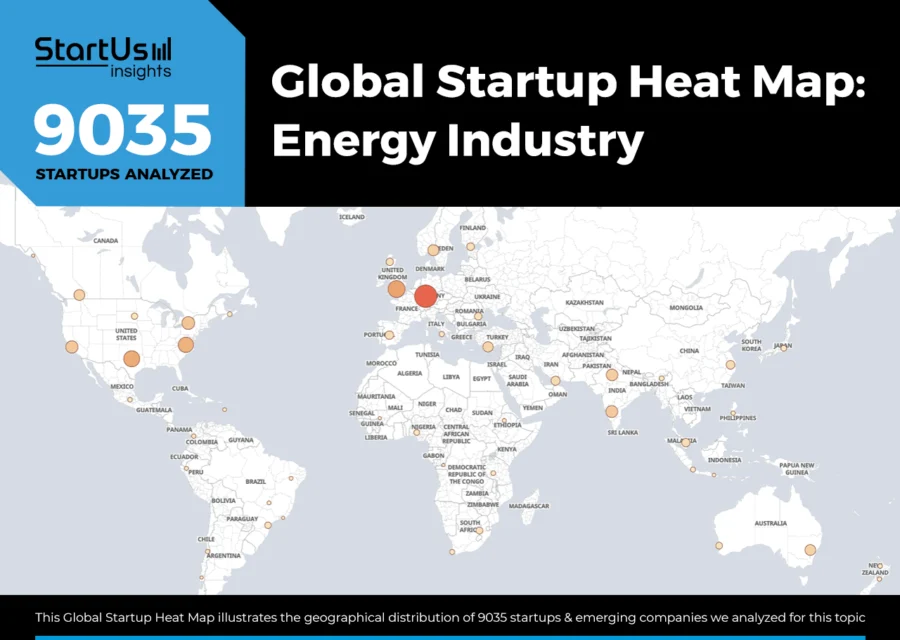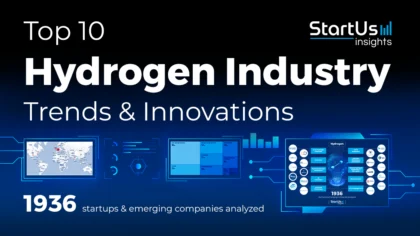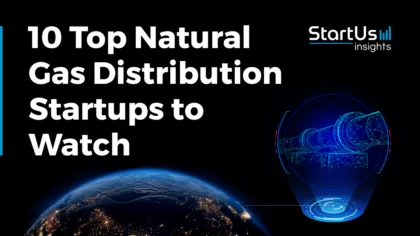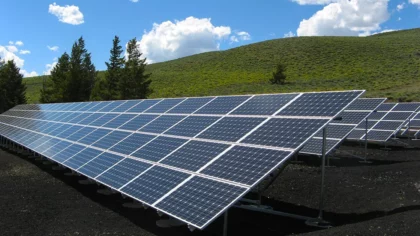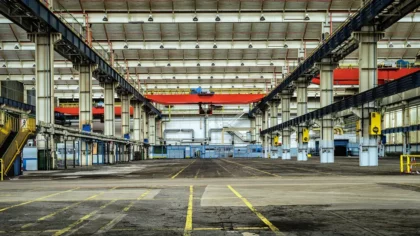The energy industry is embracing innovation to enhance efficiency, security, and sustainability in 2025. Green hydrogen, AI-powered optimization, advanced energy storage, microgrids, nuclear power, and grid resilience are some of the most critical trends impacting the energy sector.
What are the Top 10 Energy Industry Trends in 2025?
- Green Hydrogen
- Cybersecurity
- AI Integration
- Internet of Energy
- Microgrids
- Blockchain
- Energy-as-a-Service (EaaS)
- Nuclear Power
- Advanced Energy Storage
- Grid Resilience
Methodology: How We Created the Energy Industry Trend Report
For our trend reports, we leverage our proprietary StartUs Insights Discovery Platform, covering 5M+ global startups, 20K technologies & trends plus 150M+ patents, news articles, and market reports.
Creating a report involves approximately 40 hours of analysis. We evaluate our own startup data and complement these insights with external research, including industry reports, news articles, and market analyses. This process enables us to identify the most impactful and innovative trends in the energy sector.
For each trend, we select two exemplary startups that meet the following criteria:
- Relevance: Their product, technology, or solution aligns with the trend.
- Founding Year: Established between 2020 and 2025.
- Company Size: A maximum of 200 employees.
- Location: Specific geographic considerations.
This approach ensures our reports provide reliable, actionable insights into the energy innovation ecosystem while highlighting startups driving technological advancements in the industry.
Innovation Map outlines the Top 10 Energy Industry Trends & 20 Promising Startups
For this in-depth research on the Top 10 Trends & Startups in the Energy Sector, we analyzed a sample of global startups & scaleups. The Energy Innovation Map created from this data-driven research helps you improve strategic decision-making by giving you a comprehensive overview of the energy sector trends & startups that impact your company.

Tree Map reveals the Impact of the Top 10 Energy Industry Trends
The Tree Map below illustrates the major energy developments that will influence 2025. Growing investments in microgrids and grid resilience support sustainability, which is also driven by green hydrogen and advanced energy storage. Blockchain, IoT, and AI integration improve security and efficiency, while energy-as-a-service and nuclear power transform how energy is produced and used.
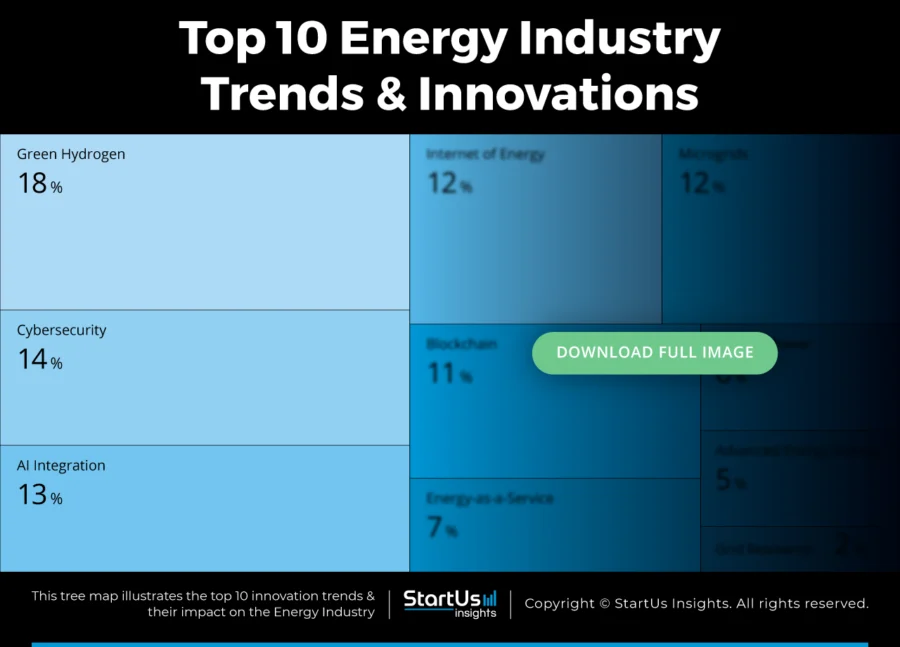
Global Startup Heat Map covers 9035 Energy Startups & Scaleups
The Global Startup Heat Map showcases the distribution of 9035 exemplary startups and scaleups analyzed using the StartUs Insights Discovery Platform. It highlights high startup activity in Germany and France, followed by the US and the UK. From these, 20 promising energy startups are featured below, selected based on factors like founding year, location, and funding.
Want to Explore Energy Industry Innovations & Trends?
Top 10 Emerging Energy Industry Trends [2025 & Beyond]
1. Green Hydrogen
Green hydrogen is rapidly emerging as a crucial element in the energy industry’s transition towards sustainability.
Since green hydrogen is created from renewable energy sources like solar and wind, it produces no carbon emissions – unlike gray and blue hydrogen.
The global green hydrogen market size is estimated to reach USD 125.3 billion by 2035 at a compound annual growth rate (CAGR) of 49.5%.
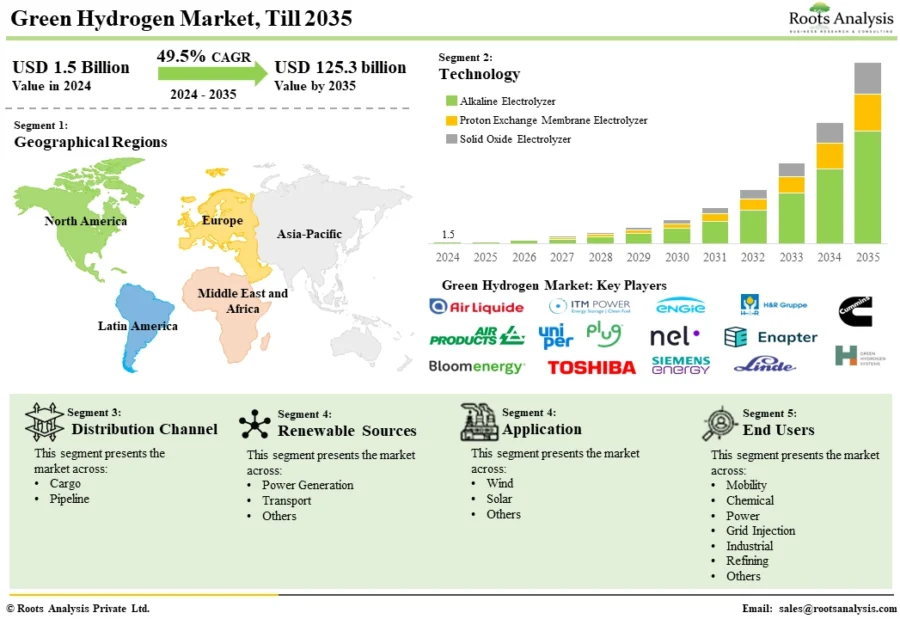
Source: Roots Analysis
Based on announced projects, low-emission hydrogen production could reach 49 million tonnes per annum (Mtpa) by 2030. This showcases a fivefold increase compared to current levels.
In industries where electrification alone is inadequate, like power generation, heavy industries, and transportation, green hydrogen is becoming more popular.
If we look at the geographical distribution of the market, the US green hydrogen market size is expected to reach USD 5305.5 million by 2033, exhibiting a CAGR of 38.2% from 2025 to 2033.
Element One Energy offers Electrolysis and Fuel Cell Systems
Norwegian startup Element One Energy develops high-efficiency electrolyzers and fuel cell systems to accelerate the adoption of green hydrogen. This technology produces hydrogen at high pressure without the need for extra compression by utilizing proton exchange membrane (PEM) electrolysis. This boosts energy efficiency and cuts expenses.
The technology is integrable into energy storage, mobility, and industrial applications due to its small size. It reduces the need for gas treatment and yields high-purity hydrogen as well as high-pressure oxygen as a valuable by-product.
The startup’s fuel cell systems support clean power generation, which converts hydrogen into electricity. It enables a shift toward carbon-free energy and industrial decarbonization. Element One Energy makes hydrogen a feasible energy carrier by developing affordable and scalable hydrogen solutions.
In 2023, the startup received around USD 31 000 in funding from Regionalt forskningsfond Vestland to collaborate with NORCE on digitally modeling and simulating their electrolyzer technology.
SOREN HYDROGEN enables Renewable Hydrogen Production
Norwegian startup SOREN HYDROGEN creates a strong digital planning tool to expedite the net-zero transition and green hydrogen projects. The platform expedites project development and enables stakeholders to make well-informed decisions quickly through the integration of financial modeling, resource evaluation, and data analytics.
The platform integrates various components—such as wind, solar, power purchase agreements (PPA), grid, electrolyzers, balance of plant (BoP), and storage sizing. This optimizes levelized cost of hydrogen (LCOH) using top-tier proton exchange membrane (PEM) and alkaline water electrolysis (AWE) electrolyzers.
The tool’s intuitive interface makes scenario analysis easier and optimizes project parameters to increase cost-effectiveness and energy efficiency. It enables enterprises to adopt green hydrogen solutions by offering thorough insights into renewable hydrogen production.
SOREN HYDROGEN’s digital planning tool accelerates the adoption of green hydrogen with the help of electrification, increased energy efficiency, the deployment of renewable energy sources, and full decarbonization.
2. Cybersecurity
The energy sector is more vulnerable to cyberthreats such as ransomware, data breaches, and operational disruptions due to legacy systems and growing digitization.
In 2023, the energy sector accounted for 11% of all cyber incidents – a figure that has nearly doubled since 2019.
Last year, the World Economic Forum‘s Global Cybersecurity Outlook report also emphasized that geopolitical tensions are contributing to a rise in cyberattacks targeting critical infrastructure – including energy systems.
The energy industry uses cloud security, blockchain-powered transactions, AI-driven threat detection, and zero-trust architecture (ZTA) to reduce risks. These technologies allow for quicker decision-making while increasing efficiency, safety, cost effectiveness, and transparency.
The global cybersecurity market associated with the energy sector is projected to grow at a CAGR of 10.5% from 2024 to 2032.

Source: UnivDatos
Cell Cyber provides Cybersecurity Software and Live-fire Simulated Training
Australian startup Cell Cyber develops advanced cybersecurity technologies to aid organizations mitigate cyber risks and strengthen digital resilience. It combines predictive cybersecurity, real-time threat monitoring, and customized security training to proactively combat changing cyberthreats.
Its AI-powered threat intelligence solution enables companies to react quickly to cyberattacks by detecting vulnerabilities before exploitation. The startup improves defenses against advanced cyberattacks, ransomware, and phishing by incorporating automated security monitoring, penetration testing, and ongoing risk assessment.
Its security training programs provide organizations with the necessary skills to recognize, stop, and react to threats to assure a human-centric defensive strategy. Cell Cyber enables businesses to protect vital assets, uphold compliance, and construct a strong digital infrastructure by emphasizing proactive protection, automation, and adaptability.
Additionally, in 2023, Australia announced a USD 387 million funding package as part of its seven-year cybersecurity strategy, aiming to strengthen the nation’s cyber defenses and position it as a world leader in cybersecurity by 2030.
Cyware simplifies Threat Intelligence Operationalization and Security
US-based startup Cyware creates cyber fusion solutions that assist enterprises in advancing security operations by combining automated threat response, collaboration, and threat intelligence sharing.
Its platform enables security professionals to connect different security data, proactively block threats, and speed up response times, which lessens the burden of repetitive activities. This allows businesses, government organizations, managed security service providers (MSSPs), and information sharing and analysis center (ISAC)/ISAOs communities to work together more effectively in real time by simplifying the intake, correlation, and distribution of threat intelligence.
Cyware’s automated threat response and orchestration allows organizations to reduce the amount of manual intervention required to contain security incidents which enhances productivity, decision-making, and overall resilience.
The startup improves security visibility and control while fortifying defenses against changing cyberthreats. By automating reaction activities and operationalizing threat intelligence.
In 2023, Cyware secured a USD 30 million Series C financing round led by Ten Eleven Ventures, with participation from previous investors including Advent International, Zscaler, Emerald Development Managers, Prelude, and Great Road Holdings.
3. AI Integration
The energy sector faces challenges like demand fluctuations, inefficient grids, and manual labor. AI integration optimizes energy distribution and consumption by addressing these problems.
The AI market in energy is projected to reach USD 22.94 billion in 2025. By 2029, it will grow to USD 50.91 billion at a CAGR of 22.0%.

Source: The Business Research Company
AI-driven autonomous energy management systems (EMS), smart grids, and digital twins enhance efficiency, sustainability, and cost-effectiveness. These technologies enable real-time monitoring, predictive maintenance, and automated energy trading to reduce downtime and resource wastage.
Additionally, digital twins create virtual replicas of energy infrastructure for optimizing performance and ensuring grid reliability. Similarly, smart grids use AI to balance supply and demand, automate energy distribution, and improve overall efficiency.
Last year, Google entered a USD 20 billion partnership with Intersect Power and TPG Rise Climate to build data centers supported by renewable power. Such initiatives address the rising energy demands driven by AI developments and other computing loads.
North America holds a significant share of AI in the energy market, accounting for slightly over 38% of the global market.
AI-powered decision-making thus enhances resilience, transparency, and customer experience. This enables the sector to manage heavy workloads with minimal human intervention assistance from humans while achieving cost savings and improved energy resilience.
DEAP VISION automates Digital Energy
French startup DEAP VISION develops AI-powered Health, Safety, and Environment (HSE) software to automate industrial workflows and enhance operational safety. The AI-HSE platform ensures adherence to international safety standards by utilizing digital technology and AI to identify safety infractions, send out real-time notifications, and predict possible risks.
It allows organizations to monitor environmental impact, manage regulatory compliance, and optimize safety practices by integrating modern data analytics. The cloud-based platform centralizes HSE data and provides risk assessment tools and predictive insights to minimize wasted time, decrease risks, and enhance decision-making.
It enables organizations to increase operational efficiency and improve worker safety by reducing human error and expediting incident reporting. DEAP VISION’s automated solutions aid businesses in increasing productivity and revenue through astute, data-driven safety management by lowering liabilities and guaranteeing workplace sustainability.
Bharat Flow Analytics advances Pipeline Monitoring and Inspection
Indian startup Bharat Flow Analytics offers advanced pipeline monitoring and inspection solutions for the energy sector, utilizing non-intrusive technologies to enhance pipeline integrity. Its solutions, iPTran and iLDS, employ enhanced pressure transient technology integrated with AI and the industrial internet of things (IIoT) to deliver real-time insights into pipeline conditions.
These devices determine the amount of wax and debris buildup, identify leaks quickly, and evaluate the general condition of the pipeline. Bharat Flow Analytics increases productivity while cutting down on maintenance expenses and downtime compared to conventional intrusive monitoring techniques.
The system aids energy firms to preserve the integrity of pipeline infrastructure through obstruction prevention, flow rate optimization, and adherence to safety and environmental laws.
The startup enables organizations to increase overall transportation efficiency, reduce operational hazards, and extend pipeline lifespan with continuous real-time monitoring and predictive maintenance capabilities, which ensures cost savings and improved system reliability.
4. Internet of Energy
The energy sector faces challenges from outdated infrastructure, unpredictable energy demand, and grid inefficiencies.
The internet of energy leverages IoT sensors, smart meters, and cloud-based analytics to facilitate automated energy management, predictive maintenance, and real-time monitoring.
These technologies optimize energy distribution and minimize waste, which, in turn, increases efficiency, transparency, and cost savings.
The global IoT market in energy is projected to grow from USD 25.97 billion in 2024 to USD 28.68 billion in 2025, reflecting a compound annual growth rate of 10.4%.
North America dominated the global IoT in energy market with a 37% share in 2024, driven by numerous energy projects and the adoption of innovative technologies.
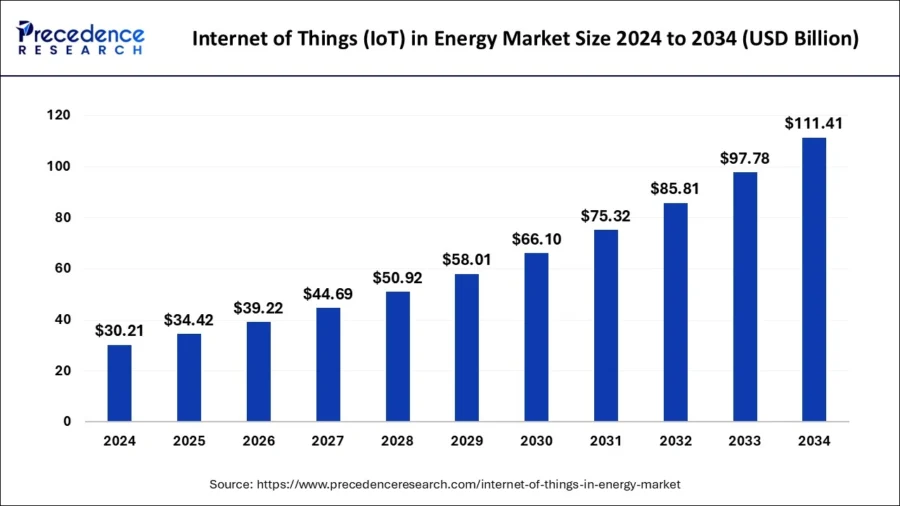
Source: Precedence Research
IoE ensures safe, data-driven energy automation and trading through the integration of blockchain and AI, resulting in a strong, intelligent, and flexible energy ecosystem that facilitates the global switch to renewable energy sources.
ivBOT simplifies Renewable Energy Assets Management
UK-based startup ivBOT provides an integrated platform for managing and optimizing renewable energy assets such as solar, wind, green hydrogen, and battery storage. Its Central Monitoring System (CMS) compiles asset performance data into a single dashboard while providing real-time analytics, insights into predictive maintenance, and tools for efficiency improvement.
The platform’s AI-driven algorithms minimize energy losses and increase production by identifying inefficiencies, anticipating maintenance requirements, and improving overall system efficiency.
ivBOT reduces downtime and simplifies operations for energy companies by offering automated control and remote access. The technology enhances load balancing and grid stability by enabling smooth coordination between several renewable assets.
The startup provides companies more insight into asset performance, which aids them in meeting sustainability targets and cutting expenses.
CONPORTLAB enables Field-to-Cloud Integration
South Korean startup CONPORTLAB offers PORTA IoT EV Charger Link, a comprehensive EV charger management solution. It provides real-time monitoring, predictive maintenance, and energy optimization for electric vehicle charging infrastructure.
The platform interfaces with EV chargers to provide automatic diagnostics, usage statistics, and intelligent load balancing to improve charging efficiency and lower energy costs. It facilitates user administration, automated problem detection, and remote monitoring of charging stations by utilizing cloud-based analytics for fleet operators and charging network providers.
The system optimizes power distribution and schedules smart charging sessions, improving grid stability by maximizing uptime and performance reliability. PORTA IoT EV Charger Link’s integrated access control and automated payment features improve user experience and expedite processes.
CONPORTLAB’s solution supports the growth of electric mobility and advances a sustainable transportation ecosystem by enhancing the efficiency, scalability, and affordability of EV charging networks.
In 2023 the startup was selected for the Little Penguin Program by the Korea Credit Guarantee Fund and was awarded the CES 2024 Innovation Award in the Embedded Technology category.
5. Microgrids
Microgrids provide localized, independent energy solutions that improve resilience by reducing dependence on centralized electricity.
Powered by renewable energy, battery storage, and intelligent energy management systems, microgrids support secure energy transactions, predictive maintenance, and real-time monitoring using blockchain, AI, and more.
For instance, Cummins and Generac reported significant growth in sales of backup power systems, driven by demand for decentralized power solutions such as solar panels, batteries, and natural gas or diesel generators. Cummins experienced a 16% year-over-year (YoY) increase in quarterly sales for backup power systems, totaling USD 987 million.
The global microgrid market was valued at approximately USD 22.9 billion in 2024 and is projected to grow at a compound annual growth rate (CAGR) of 19.2% from 2025 to 2034.
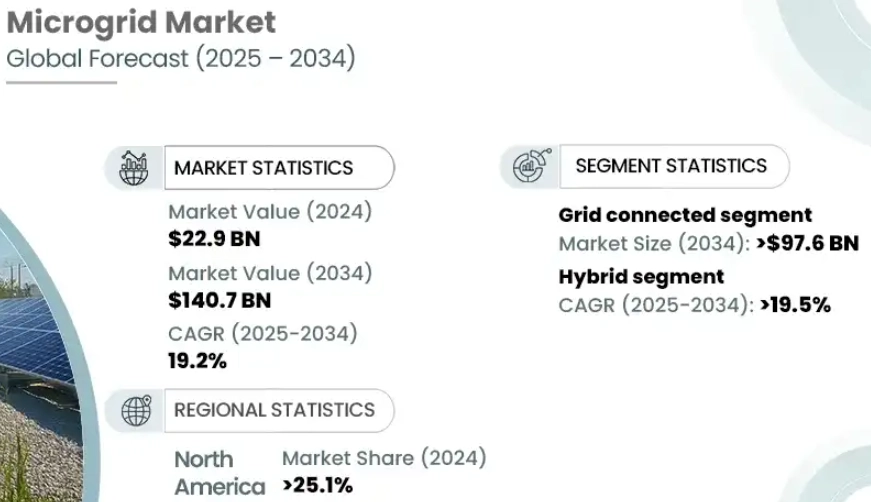
Source: Global Market Insights
Microgrids ensure a steady supply of electricity and improve decision-making by lowering costs, increasing transparency, and optimizing energy distribution. Microgrids improve safety, dependability, and customer satisfaction by managing heavy loads with little human involvement.
The microgrid-as-a-service market is anticipated to grow from USD 2.41 billion in 2024 to USD 2.73 billion in 2025, at a CAGR of 13.4%.

Source: The Business Research Company
Direct Energy Partners creates a Microgrid Design Software
US-based startup Direct Energy Partners develops DCIDE, an advanced microgrid design software that simplifies the engineering and deployment of ultra-efficient decentralized microgrids. It offers a quick microgrid design framework, and automated design rule verification to ensure component compatibility and adherence to DC microgrid standards.
DCIDE significantly lowers the soft costs of microgrid engineering, planning, and procurement by simplifying the design process. The platform incorporates real-time modeling tools to improve grid resilience, optimize electricity distribution, and assess system performance.
Its intelligent configuration capabilities enable companies to create sustainable, scalable energy networks that optimize the use of renewable energy sources while reducing system losses. Direct Energy Partners’ products ensure long-term energy stability, cost effectiveness, and sustainability for industrial and commercial applications by promoting the deployment of decentralized microgrids.
Additionally, ABB invested in Direct Current microgrid start-up Direct Energy Partners to accelerate energy transformation.
Elecod provides Microgrid Multi-energy Solutions
Chinese startup Elecod creates integrated microgrid multi-energy systems to maximize the distribution of energy in different industries. Its technology combines energy storage devices, sophisticated control algorithms, and renewable energy sources to provide strong and effective microgrids.
The system’s smooth integration of solar, wind, and battery ensures storage power delivery, which balances energy supply and demand. The platform’s predictive analytics and real-time monitoring improve operational effectiveness and lessen dependency on conventional power grids.
Elecod’s modular architecture aids communities and businesses to implement scalable microgrids that meet their energy requirements. Its technologies offer affordable and environmentally friendly energy substitutes by supporting demand-side management, peak shaving, and grid stability.
Elecod promotes energy independence and lowers carbon footprints to ensure resilience against grid outages and increase energy security for commercial, residential, and industrial applications.

6. Blockchain
The global blockchain market associated with energy utilities is projected to grow from USD 1.23 billion in 2025 to USD 4.8 billion in 2029 at a compound annual growth rate of 40.6%.
The energy industry faces challenges like lack of transparency, inefficiencies in energy trading, and grid security risks. Blockchain technology solves these problems through smart contracts, real-time traceability, and safe, peer-to-peer (P2P) energy transfers.
By integrating tokenized carbon credits, peer-to-peer energy trading, and tamper-proof records, blockchain boosts sustainability, lowers costs, and increases efficiency.
Direct trading between energy providers and customers is made possible by its optimization of grid management, fraud reduction, and data quality. Blockchain speeds up procedures, improves security, and creates a transparent, effective, and resilient energy network with automated, trustless transactions while removing intermediaries.
Europe led the blockchain in the energy market in 2024, holding a 38% share, with revenues at USD 1.94 billion. Germany dominated within Europe, contributing USD 0.5 billion in 2024 and maintaining steady expansion at a CAGR of 50.3%.
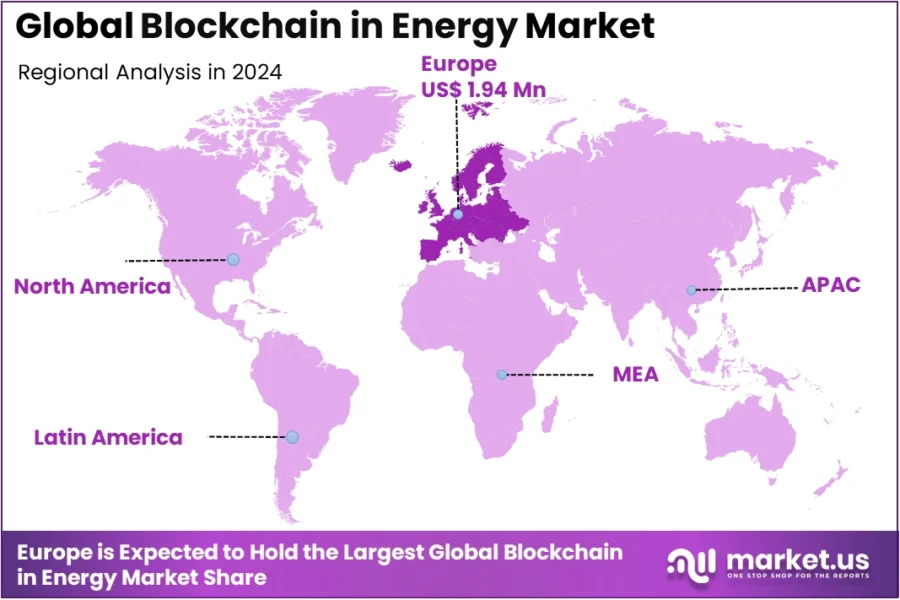
Source: Market.us Scoop
C4E offers a Blockchain Infrastructure for the Energy Market
Swiss startup C4E provides blockchain technology for the energy sector, enabling safe and open exchanges between grid operators, producers, and consumers. Its decentralized ledger technology facilitates peer-to-peer energy trade, automates contract execution through smart contracts, and ensures data integrity.
The platform expedites compliance and verification procedures by facilitating grid flexibility, carbon credit tracking, and energy certificate digitization. C4E improves energy transaction visibility and trust by combining blockchain technology with smart metering and IoT devices.
The system facilitates decentralized renewable energy exchanges, minimizes inefficiencies, and optimizes trading procedures for energy market participants. Its flexible framework supports a wide range of energy assets, from small-scale solar generators to large utilities, promoting an open and just energy economy.
The startup’s technology offers a decentralized, fraud-proof marketplace for sustainable energy investments, boosts grid security, and speeds up the adoption of green energy.
In 2024, C4E partnered with Native to enhance Bitcoin’s utility within its energy and e-mobility ecosystem. This collaboration integrates Bitcoin into C4E’s products, leveraging Native’s Bitcoin Liquidity and Interoperability Scaling Stack (BLISS).
Solareum designs Layer 1 Blockchain Green Energy
UAE based startup Solareum develops a Layer 1 blockchain platform dedicated to green energy initiatives, providing a secure and scalable foundation for tokenizing renewable energy assets. Its blockchain platform allows businesses and individuals to invest in renewable energy while maintaining responsibility due to the transparent, decentralized trade of energy credits.
The platform incorporates smart contracts by automating energy transfers and removing middlemen, which lowers administrative expenses. Solareum’s ecosystem facilitates the tracking and verification of renewable energy generation with real-time transparency into sustainable energy projects.
The startup uses blockchain’s immutability to improve energy market trust and make environmental standards easier to comply with. The platform’s decentralized structure enables green energy finance to be widely adopted, and renewable energy adoption is encouraged worldwide.
In 2025, Solareum announced the launch of a comprehensive funding program aimed at supporting development projects within its ecosystem.
7. Energy-as-a-Service
The energy industry faces challenges like high upfront costs, inefficient energy management, and complex infrastructure maintenance. Energy-as-a-service tackles these issues by improving demand response and smart grid optimization as well as delivering subscription-based energy solutions.
The EaaS sector comprises numerous key players, including major companies such as ENGIE, Enel X, Schneider Electric, Siemens, and Honeywell.
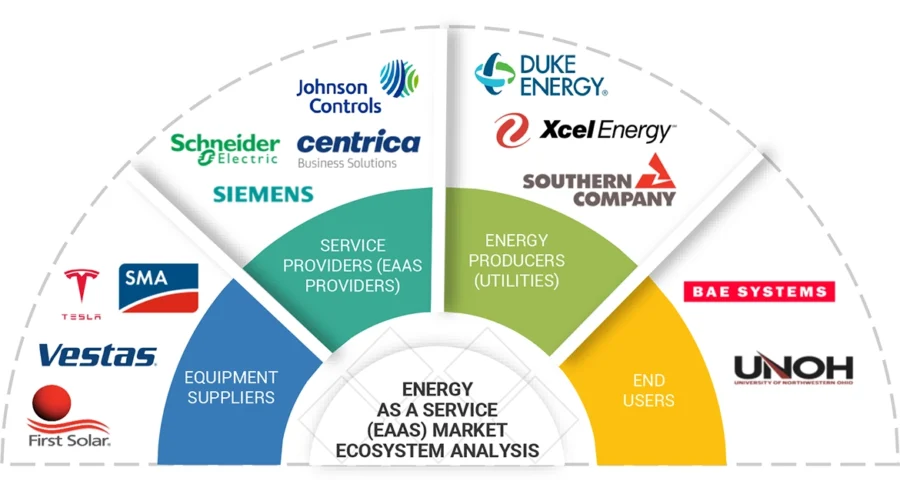
Source: MarketandMarkets
EaaS providers use IoT, cloud analytics, and predictive maintenance to maximize energy use, minimize waste, and cut expenses. This strategy increases efficiency and transparency for businesses through flexible, pay-as-you-use energy solutions.
The global EaaS market is projected to grow at a compound annual growth rate of 12.3% from 2025 to 2030.
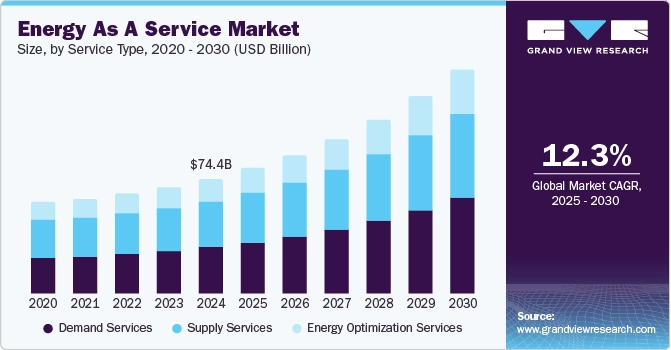
Source: Grand View Research
The U.S. EaaS market size alone is predicted to be worth around USD 60.46 billion by 2034, at a CAGR of 9.90% from 2025 to 2034.

Source: Precedence Research
nextE offers Energy Generation Solutions
Swiss startup nextE provides advanced energy generation solutions to enhance efficiency, reliability, and sustainability across diverse applications. It offers solar, wind, and hybrid power systems for commercial, residential, and industrial applications.
NextE minimizes environmental effects and maximizes energy output through the use of advanced engineering and materials. The startup’s scalable modular energy solutions allow consumers to increase their generation capacity as demand increases.
Its predictive maintenance and real-time monitoring features maximize system performance by minimizing downtime and guaranteeing long-term efficiency. The startup enables communication with distributed energy networks in an uninterrupted manner, improving grid stability by incorporating smart grid connectivity.
Its focus on sustainability aids with worldwide decarbonization initiatives by offering affordable, renewable energy options.
360energy offers Pay-as-you-go (PAYGO) subscription
Indonesian startup 360energy allows customers to use renewable energy solutions without incurring large upfront expenses by providing a pay-as-you-go (PAYGO) subscription model for energy access.
Its platform combines data analytics, mobile payments, and smart metering to offer a range of flexible energy consumption options. The technology improves the accessibility and cost of sustainable energy by enabling users to pay for energy according to usage.
The PAYGO concept is beneficial in areas where traditional electricity availability is restricted in underserved communities. 360energy’s technology ensures a smooth customer experience by enabling automatic invoicing and remote monitoring of energy consumption.
The system provides communities access to sustainable energy options by facilitating the installation of mini-grids, solar household systems, and battery storage devices. It improves demand forecasting and energy efficiency by the platform’s integration of IoT connections.
In 2024, 360Energy secured a USD 100 million investment from Stellantis, acquiring a 49.5% stake.
8. Nuclear Power
Growing electricity demand, carbon emissions, and grid dependability issues are critical challenges for the energy sector. In response, advancements in fusion technology, small modular reactors (SMRs), and molten salt reactors are enhancing the safety, scalability, and economic viability of nuclear power, reinforcing its role as a reliable, low-carbon energy source.
Global nuclear power generation is projected to grow significantly by 2025, with an anticipated annual growth of nearly 3% through 2026.
When combined with renewable energy, nuclear fusion, SMRs, and molten salt reactors increase sustainability, lower operational risks, and boost efficiency for a balanced grid. Optimizing reactor performance with AI-driven monitoring, automation, and predictive maintenance further increases safety, lowers costs, and ensures transparency.
The nuclear power market is forecasted to reach USD 44.71 billion by 2029, at a compound annual growth rate of 2.9%.
Further, Amazon Web Services recently announced a USD 500 million investment into X-energy to bring four small modular reactors online in Washington state. Similarly, Google signed a deal with Kairos Power to purchase 500 MW of power from next-generation reactors.
In addition to providing cleaner energy, nuclear power enhances energy security and advances global decarbonization objectives.
Calogena makes a Zero Carbon Nuclear Heat Generator
French startup Calogena creates sustainable heating solutions by employing small modular reactor (SMR) technology to create nuclear heat generators with zero carbon emissions. Its 30 MW thermal water-cooled SMR is designed for district heating applications, offering a compact and efficient alternative to fossil fuel-based systems.
The reactor’s low-pressure, low-temperature operation improves safety while reducing building timeframes and enabling factory assembly. Calogena ensures dependable heat generation with minimal environmental effects by utilizing established nuclear technology.
The system includes advanced passive safety safeguards to eliminate the risk of catastrophic failure while maintaining continuous operation. The startup’s nuclear heat generator aids achieve worldwide decarbonization objectives by lowering CO2 emissions related to heat production.
Its extended operational lifespan and fuel efficiency is a cost-effective alternative for industrial applications, metropolitan heating networks, and energy-intensive buildings looking for carbon-free heating options.
In 2023 Calogena took another step forward by filing three patents in the field of SMR.
CAELUS offers a Nuclear Reactors Licensing Processes Software
Italian startup CAELUS creates software solutions to expedite nuclear reactor licensing procedures and ensure compliance with changing nuclear safety regulations. Its digital platform lowers administrative workloads and speeds up approval processes by automating documentation, regulatory filings, and compliance tracking.
CAELUS reduces human error and improves regulatory file accuracy by combining workflow automation and AI-driven data validation. The system facilitates cooperation amongst stakeholders, including regulators, plant operators, and engineering teams, and ensures conformity with international nuclear safety laws.
The startup offers real-time license status tracking, which enhances decision-making and transparency in nuclear energy projects. Its technology streamlines nuclear licensing processes, lowers costs, and makes it easier to install next-generation nuclear reactors.
9. Advanced Energy Storage
Advanced energy storage technologies reduce peak demand costs, renewable energy intermittency, and system instability. Solutions like solid-state, lithium-ion, and zinc-air batteries, as well as pumped hydro and hydrogen storage, address these problems.
The advanced energy storage systems market is projected to grow from USD 21.08 billion in 2025 to USD 29.8 billion in 2029 at a CAGR of 9.0%.
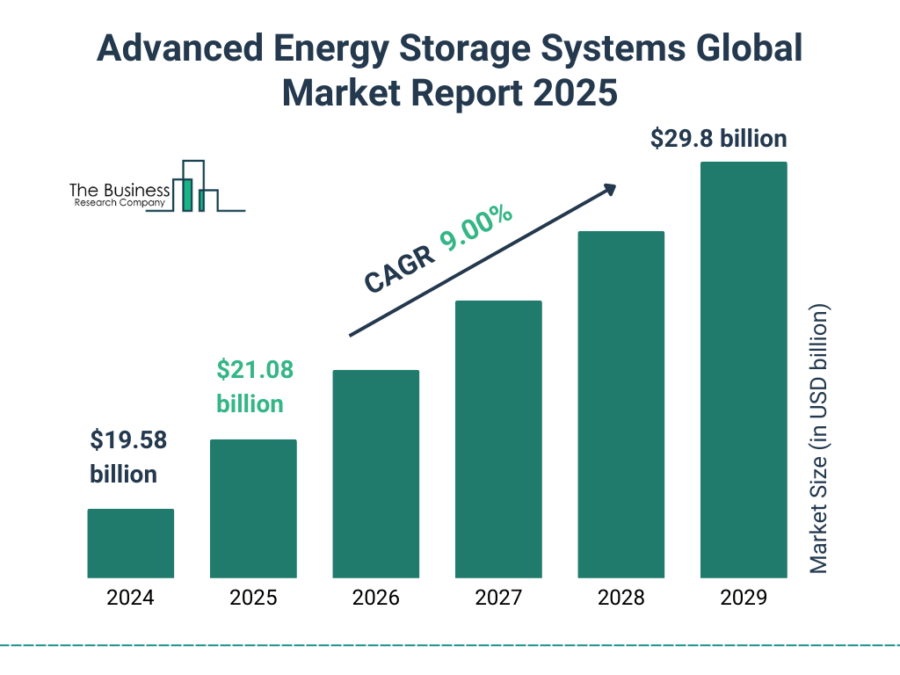
Source: The Business Research Company
Solutions like solid-state, lithium-ion, and zinc-air batteries enable real-time energy management, load balancing, and demand response. This ensures increased sustainability and efficiency.
Further, battery storage capacity in Europe is anticipated to expand significantly by 2030, requiring investments of approximately USD 82.45 billion.
Advanced storage also provides scalable and affordable solutions for households and businesses to support a resilient, low-carbon future.
Asia-Pacific was the largest region in the advanced energy storage systems market in 2024.
Advenst provides Zinc-Air Energy Storage Systems
Turkish startup Advenst creates zinc-air energy storage technologies to give renewable power systems high-capacity, cost-effective energy storage. Its zinc-air batteries, which use abundant and recyclable ingredients, provide a safer and more environmentally friendly substitute for conventional lithium-ion storage.
The technology is suitable for off-grid applications, grid balancing, and renewable energy integration as it allows for long-duration energy storage. Advenst’s technologies provide long-term operating reliability by providing high energy density with little deterioration.
The startup’s scalable modular design enables utilities and companies to implement adaptable storage systems that meet changing energy needs. The startup encourages ecologically friendly energy storage and improves supply chain resilience by lowering reliance on essential raw materials.
This zinc-air technology strengthens energy security and facilitates the shift to sustainable energy storage by allowing for more effective utilization of renewable resources.
Hubble Energy makes Lithium-ion Battery Technologies
South African startup Hubble Energy creates lithium-ion battery technology for scalable energy storage options for commercial, industrial, and household uses. It offers containerized solutions and high-voltage racks for large-scale energy storage requirements.
The high-voltage racks provide effective energy storage with quick deployment capacity while the container solutions offer flexible, transportable storage choices that easily incorporate into current power infrastructures.
Hubble Energy’s Cloudlink platform systems offer smart management and real-time monitoring, allowing customers to maximize efficiency and ensure system dependability. The startup promotes the switch to renewable energy sources and increases energy resilience by providing adaptable and effective energy storage solutions.
10. Grid Resilience
Extreme weather events, cyber attacks, and legacy infrastructure cause grid instability and disruptions. Energy storage, microgrids, AI-driven predictive maintenance, and self-healing grid technologies identify such problems, reroute electricity, and automatically restore services. This contributes to increased grid resilience.
California plans to invest an average of USD 16.5 billion per year over 2025-2026 to enhance its power grids. The project will focus on undergrounding wires for wildfire resilience and integrating renewable energy sources.
Such developments increase energy distribution’s transparency, efficiency, and downtime. Utilities are also able to manage heavy workloads with lesser assistance from humans with automation and real-time monitoring. This results in lower costs, increased safety, and enhanced decision-making.
The global energy resilience market is projected to grow from USD 49.99 billion in 2025 to USD 95.64 billion by 2032, reflecting a CAGR of 9.7% during this period.
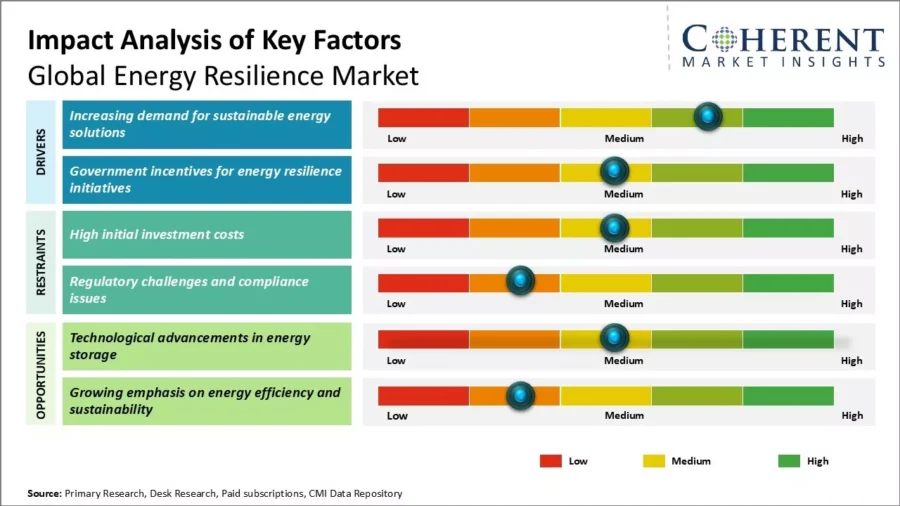
Source: Coherent Market Insights
NAVIA ENERGY enables AI Digital Twin Energy Resilience
US-based startup NAVIA ENERGY creates AI-powered digital twin platforms to improve grid stability and energy resilience. Its technology enables real-time monitoring and predictive analysis by building detailed virtual models of microgrids and distributed energy resources (DERs).
The platform predicts system behavior and optimizes reactions by simulating a variety of scenarios, such as unfavorable weather events, cyberattacks, and grid disruptions to provide a continuous power supply.
The solution aids operators achieve net-zero targets and efficiently manage energy budgets with its mission-oriented decision support and forward-looking planning capabilities. It also offers intelligence-driven energy dispatch and cyber threat detection to ensure operational security.
It supports services like reactive power management, demand response, and grid stability, which improves power delivery quality and the environment. The startup enables users to attain cost savings, environmental sustainability, and energy security utilizing AI and digital twin technologies.
Solus Power advances EV Charging Infrastructure
UK-based startup Solus Power specializes in off-grid rapid electric vehicle (EV) charging and energy storage solutions, addressing the growing demand for flexible and sustainable energy infrastructure. Its product Titan is an energy storage and off-grid, fast EV charging device for both commercial and military use.
Titan is beneficial for a range of settings, such as parking lots at airports, car-rental agencies, and isolated or disaster-affected locations due to its portability and quick deployment. It offers effective charging solutions that improve operational efficiency as it operates independently of conventional power networks.
In 2024 Solus Power secured an approximately USD 28 million investment from Dubai-based Petra Equity Partners. Additionally, Solus Power and QinetiQ announced collaboration to find solutions for an electrified battlespace.
Discover all Energy Trends, Technologies & Startups
The energy sector is set for major growth, with smarter grids, better energy storage, and decentralized power becoming more common. AI-powered energy management, advanced batteries, and hydrogen solutions will make energy systems more efficient and reliable. As the energy resilience market nearly doubles by 2032, investments in smart grids, microgrids, and renewables will help create a more secure and sustainable future.
The Energy Trends & Startups outlined in this report only scratch the surface of trends that we identified during our data-driven innovation & startup scouting process. Identifying new opportunities & emerging technologies to implement into your business goes a long way in gaining a competitive advantage.
![Dive into the Top 10 Energy Industry Trends and Innovations [2025]](https://www.startus-insights.com/wp-content/uploads/2025/03/Energy-Trend-SharedImg-StartUs-Insights-noresize-420x236.webp)

